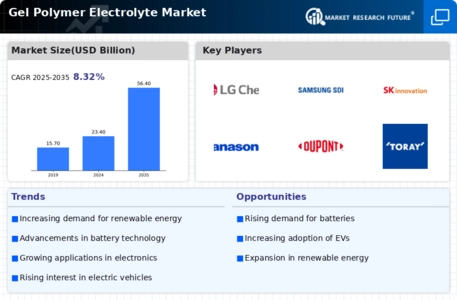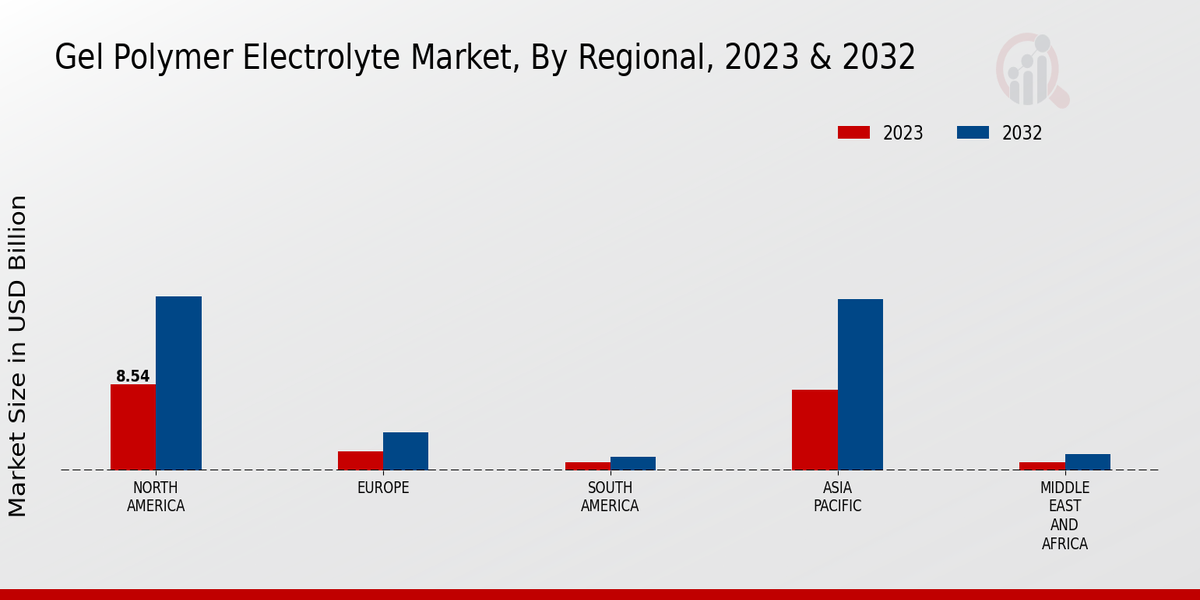Market Growth Projections
The Global Gel Polymer Electrolyte Market Industry is projected to experience substantial growth over the next decade. With the market valued at 23.4 USD Billion in 2024, it is anticipated to reach 56.4 USD Billion by 2035, reflecting a compound annual growth rate of 8.32% from 2025 to 2035. This growth trajectory indicates a robust demand for gel polymer electrolytes across various applications, including energy storage systems and electric vehicles. The increasing emphasis on sustainability and technological advancements in battery technologies are expected to drive this market expansion, positioning gel polymer electrolytes as a critical component in future energy solutions.
Government Initiatives and Funding
Government initiatives and funding aimed at promoting clean energy technologies are significantly influencing the Global Gel Polymer Electrolyte Market Industry. Various countries are investing in research and development to enhance battery technologies, including gel polymer electrolytes, as part of their commitment to reducing carbon emissions. These initiatives not only provide financial support but also create a favorable regulatory environment for the adoption of advanced battery solutions. As a result, the market is poised for growth, with increased collaboration between public and private sectors likely to accelerate advancements in gel polymer electrolyte technologies.
Growing Consumer Electronics Sector
The burgeoning consumer electronics sector is fueling the growth of the Global Gel Polymer Electrolyte Market Industry. With the increasing demand for portable electronic devices, such as smartphones, tablets, and wearables, the need for efficient and lightweight battery solutions becomes critical. Gel polymer electrolytes offer advantages such as improved safety and energy density, making them suitable for modern electronic applications. As consumer preferences shift towards high-performance devices, the market for gel polymer electrolytes is likely to expand, driven by innovations in battery technology that cater to the evolving needs of consumers.
Expansion of Electric Vehicle Market
The rapid expansion of the electric vehicle (EV) market is a key driver for the Global Gel Polymer Electrolyte Market Industry. As governments worldwide implement stricter emissions regulations and consumers shift towards sustainable transportation options, the demand for efficient and reliable battery technologies rises. Gel polymer electrolytes play a vital role in enhancing the performance of EV batteries, contributing to longer ranges and faster charging times. This growing trend is expected to significantly impact the market, with the industry projected to reach 56.4 USD Billion by 2035, indicating a robust future for gel polymer electrolytes in the automotive sector.
Rising Demand for Renewable Energy Solutions
The Global Gel Polymer Electrolyte Market Industry is experiencing a surge in demand driven by the increasing adoption of renewable energy sources, particularly in energy storage systems. As countries strive to meet sustainability goals, the need for efficient energy storage solutions becomes paramount. Gel polymer electrolytes are integral to the development of advanced batteries, such as lithium-ion and solid-state batteries, which are essential for renewable energy applications. This trend is projected to contribute significantly to the market, with the industry expected to reach 23.4 USD Billion in 2024 and potentially expand further as global energy policies evolve.
Technological Advancements in Battery Technologies
Technological innovations in battery technologies are propelling the Global Gel Polymer Electrolyte Market Industry forward. The development of high-performance gel polymer electrolytes enhances the efficiency and safety of batteries, making them more appealing for various applications, including electric vehicles and portable electronics. These advancements not only improve energy density but also extend battery life, which is crucial for consumer acceptance. As a result, the market is likely to witness substantial growth, with projections indicating a compound annual growth rate of 8.32% from 2025 to 2035, reflecting the increasing reliance on advanced battery systems.




















Leave a Comment